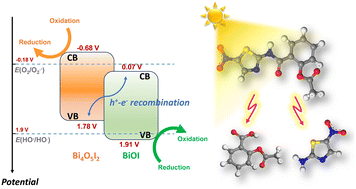Unveiling the origin of the efficient photocatalytic degradation of nitazoxanide over bismuth (oxy)iodide crystalline phases†
Abstract
Conventional wastewater treatment has been found to be ineffective at fully removing various antiviral drugs and emerging pollutants from wastewater. As an advanced oxidation process, heterogeneous photocatalysis is promising for detoxifying such water pollutants due to its mild operating conditions and efficiency. In this study, we explore the oxidative phase transition from bismuth iodide to bismuth oxyiodides by altering the temperature and time of thermal treatment. The influence of the temperature change from 350 °C to 450 °C on the phase transition from bismuth iodide to bismuth oxyiodides is more pronounced compared with the impact of time. This results in the formation of different bismuth oxyiodide crystalline phases with varying optoelectronic properties and photocatalytic activity. The effect of the bismuth iodide-to-bismuth oxyiodide phase transition on the efficiency of the photocatalytic removal of nitazoxanide is investigated in this study. The significant role of the BiOI/Bi4O5I2 heterostructure is established in facilitating the rapid photocatalytic degradation of nitazoxanide, with respective rate constants of k1 (0.051 min−1) and k2 (4.225 mg g−1 min−1) obtained for the photocatalyst sample thermally treated at 375 °C for 1 h. Trapping experiments provide evidence that photoexcited holes and hydroxyl radicals play a crucial role in the photocatalytic degradation of nitazoxanide. The photodegradation of nitazoxanide in aqueous solution over crystalline bismuth (oxy)iodide proceeds via hydrolysis into acetylsalicylic acid and the respective aminonitrothiazol, followed by the deacetylation and decarboxylation processes. Molecular dynamics simulation confirms that the high photocatalytic activity of BiOI/Bi4O5I2 is correlated to the higher adsorption energy due to the formation of a network of close contacts (<3.5 Å) between nitazoxanide molecules and iodine atoms.

- This article is part of the themed collections: Recent Open Access Articles and Environmental Remediation


 Please wait while we load your content...
Please wait while we load your content...